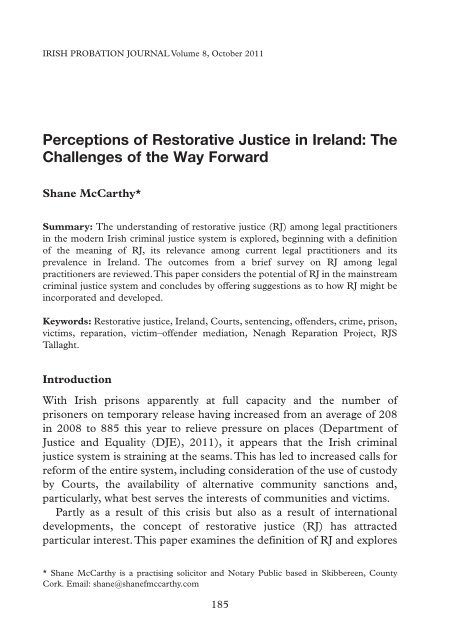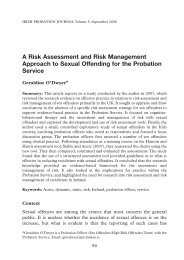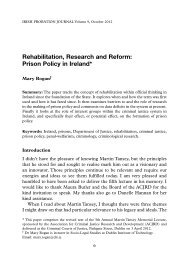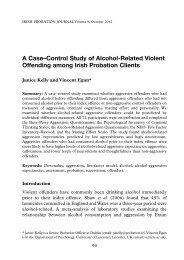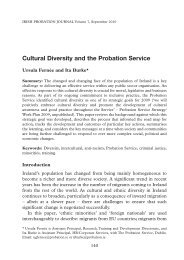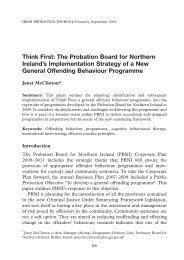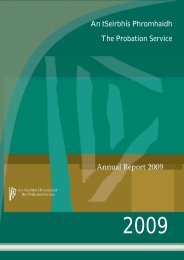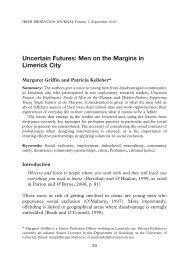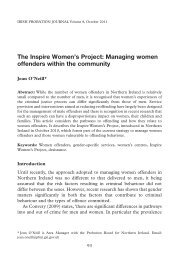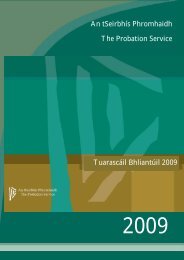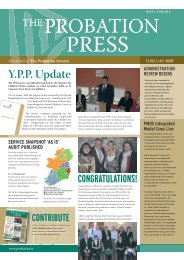Perceptions Of Restorative Justice In Ireland - The Probation Service
Perceptions Of Restorative Justice In Ireland - The Probation Service
Perceptions Of Restorative Justice In Ireland - The Probation Service
You also want an ePaper? Increase the reach of your titles
YUMPU automatically turns print PDFs into web optimized ePapers that Google loves.
IRISH PROBATION JOURNAL Volume 8, October 2011<br />
<strong>Perceptions</strong> of <strong>Restorative</strong> <strong>Justice</strong> in <strong>Ireland</strong>: <strong>The</strong><br />
Challenges of the Way Forward<br />
Shane McCarthy*<br />
Summary: <strong>The</strong> understanding of restorative justice (RJ) among legal practitioners<br />
in the modern Irish criminal justice system is explored, beginning with a definition<br />
of the meaning of RJ, its relevance among current legal practitioners and its<br />
prevalence in <strong>Ireland</strong>. <strong>The</strong> outcomes from a brief survey on RJ among legal<br />
practitioners are reviewed. This paper considers the potential of RJ in the mainstream<br />
criminal justice system and concludes by offering suggestions as to how RJ might be<br />
incorporated and developed.<br />
Keywords: <strong>Restorative</strong> justice, <strong>Ireland</strong>, Courts, sentencing, offenders, crime, prison,<br />
victims, reparation, victim–offender mediation, Nenagh Reparation Project, RJS<br />
Tallaght.<br />
<strong>In</strong>troduction<br />
With Irish prisons apparently at full capacity and the number of<br />
prisoners on temporary release having increased from an average of 208<br />
in 2008 to 885 this year to relieve pressure on places (Department of<br />
<strong>Justice</strong> and Equality (DJE), 2011), it appears that the Irish criminal<br />
justice system is straining at the seams. This has led to increased calls for<br />
reform of the entire system, including consideration of the use of custody<br />
by Courts, the availability of alternative community sanctions and,<br />
particularly, what best serves the interests of communities and victims.<br />
Partly as a result of this crisis but also as a result of international<br />
developments, the concept of restorative justice (RJ) has attracted<br />
particular interest. This paper examines the definition of RJ and explores<br />
* Shane McCarthy is a practising solicitor and Notary Public based in Skibbereen, County<br />
Cork. Email: shane@shanefmccarthy.com<br />
185
186 Shane McCarthy<br />
the extent of knowledge and understanding that key legal figures in the<br />
District Court have of RJ. Finally, it examines some of the issues and<br />
potential barriers in the introduction of a comprehensive RJ programme<br />
in <strong>Ireland</strong> and steps required to ensure the success of such an<br />
undertaking.<br />
Firstly it is necessary to explore briefly what RJ is.<br />
What is restorative justice?<br />
<strong>Restorative</strong> justice as a concept is governed by key principles and is<br />
implemented across jurisdictions using processes and practices<br />
consistent with local legal and cultural frameworks. <strong>In</strong> <strong>Ireland</strong> it is<br />
therefore important to understand the context within which the debate<br />
on RJ is sited.<br />
<strong>In</strong> March 2007 the Minister for <strong>Justice</strong>, Equality and Law Reform,<br />
Michael McDowell TD, announcing the appointment of a National<br />
Commission on <strong>Restorative</strong> <strong>Justice</strong>, said:<br />
<strong>Restorative</strong> <strong>Justice</strong> is a victim and community oriented approach<br />
which requires the perpetrator to face up to the harm that he or she<br />
has caused and repair or make good the damage done. <strong>Restorative</strong><br />
<strong>Justice</strong> puts the victim at the centre of the process. I want to see how<br />
it can be expanded in <strong>Ireland</strong> with appropriate structures and a sound<br />
funding base. (Department of <strong>Justice</strong>, Equality and Law Reform<br />
(DJELR), 2007)<br />
<strong>The</strong> Commission in its final report (DJELR, 2009, p. 46), in considering<br />
how RJ might best suit an Irish context, agreed that the general principles<br />
of RJ included:<br />
1. that crime is a violation<br />
2. that this violation creates an obligation<br />
3. that RJ can fulfil this obligation.<br />
<strong>The</strong> Commission also agreed that programmes generally involved a<br />
process based on face-to-face interactions between victim, offender and<br />
the community (DJELR, 2009). <strong>The</strong> National Commission on<br />
<strong>Restorative</strong> <strong>Justice</strong> defined RJ as:
<strong>Perceptions</strong> of <strong>Restorative</strong> <strong>Justice</strong> in <strong>Ireland</strong> 187<br />
a victim-sensitive response to criminal offending, which through<br />
engagement with those affected by crime, aims to make amends for<br />
the harm that has been caused to victims and communities and which<br />
facilitates offender rehabilitation into society. (DJELR, 2009a)<br />
On 17 December 2009 the Minister for <strong>Justice</strong>, Equality and Law<br />
Reform, Dermot Ahern TD, published the Final Report of the National<br />
Commission on <strong>Restorative</strong> <strong>Justice</strong>. Thanking the Commission, the<br />
Minister said:<br />
We need to be responsive to the needs of victims and use the criminal<br />
justice resources effectively to provide protection, redress and<br />
rehabilitation … <strong>The</strong> experience elsewhere and from the two pilot<br />
projects indicate that restorative justice serves as a real alternative to<br />
locking offenders up, reduces reoffending and allows victims a sense<br />
that they are at the centre of the justice system. (DJELR, 2009b)<br />
<strong>In</strong> Dáil Éireann on 25 November 2010 the Minister announced ‘a<br />
scheme … to test a range of restorative interventions for adult offenders<br />
based on the recommendations contained in the report’. He went on to<br />
say: ‘<strong>The</strong> objective of the scheme is to build the foundation for the<br />
implementation of a robust restorative justice model of practice<br />
providing an alternative to a prison sentence of less than 12 months’<br />
duration’. <strong>The</strong> <strong>Probation</strong> <strong>Service</strong> was given responsibility to monitor,<br />
oversee and evaluate the implementation of an RJ scheme and to report<br />
on the effectiveness and value for money of the model after a 12-month<br />
operational period (Dáil Éireann, 2010).<br />
<strong>The</strong> Minister has clearly indicated his Department’s interest in and<br />
commitment to a role for RJ in the Irish criminal justice system; so, what<br />
exactly do people – and, in particular, practitioners in criminal law work<br />
– know about RJ?<br />
What do legal practitioners in a District Court know about<br />
restorative justice?<br />
During 2010 I conducted a limited interview-based survey among 12<br />
defence solicitors representing defendants in criminal law proceedings at<br />
a District Court in a provincial town. <strong>The</strong> survey was designed to<br />
measure knowledge and understanding of the principles of RJ. <strong>In</strong>
188 Shane McCarthy<br />
addition I later interviewed an experienced District Judge using the same<br />
survey structure, and a solicitor experienced in RJ practice.<br />
<strong>The</strong> first question enquired as to whether the solicitors knew what RJ<br />
entailed. <strong>The</strong> responses were extremely varied, ranging from a complete<br />
lack of awareness of the subject to people saying ‘I have a vague idea – it<br />
is to do with compensation’ to ‘Yes, I have been involved in a case in<br />
which the principles of it were applied’. <strong>The</strong> most notable feature was<br />
that 75% of those questioned did not know what RJ involved.<br />
It is significant that so many of these practitioners did not know about<br />
the basic concepts of RJ – a system that is established in other<br />
jurisdictions and is the subject of a recent National Commission Report,<br />
and is part of the Irish criminal justice system having been operated as<br />
pilot schemes by Nenagh Community Reparation Programme since June<br />
1999 and <strong>Restorative</strong> <strong>Justice</strong> <strong>Service</strong>s in Tallaght since 2000.<br />
This gap in the knowledge of legal practitioners and possibly also<br />
among other key players and stakeholders within the Irish criminal<br />
justice system with regard to this entire area of law represents a major<br />
challenge in the effective establishment of a RJ system. It could be argued<br />
that, as in many professions, lack of knowledge and enthusiasm for a<br />
potential development is influenced by a narrow focus on the status quo,<br />
and a disinclination to consider change.<br />
A further possible dampener of the appetite for change could be that<br />
criminal defence law, as currently structured, can be a lucrative area of<br />
practice and that change could threaten livelihoods. Self-interest is not<br />
limited to lawyers; it is a charge also frequently made against other<br />
professions, memorably by George Bernard Shaw when he wrote that<br />
‘All professions are conspiracies against the laity’ (Shaw, 1906).<br />
Responsibility for lack of progress in the expansion of the RJ in <strong>Ireland</strong><br />
cannot be laid solely at the door of the legal profession. It is however<br />
logical that this current situation will endure until there is real<br />
momentum from the Government and associated incentives to carry<br />
through on the Minister’s stated intention to expand this concept.<br />
Victims<br />
After identifying a lack of awareness of RJ among a sizeable majority of<br />
the solicitors interviewed, I proceeded to explain RJ as a process in which<br />
the offender and the victim can be brought together in a supervised,<br />
structured setting. I asked whether or not those practitioners thought
<strong>Perceptions</strong> of <strong>Restorative</strong> <strong>Justice</strong> in <strong>Ireland</strong> 189<br />
benefit could arise from such a meeting. <strong>The</strong> answers to this question<br />
revealed myriad considerations from ‘One advantage is that the victim<br />
would know the outcome of the process. At the moment the victim can<br />
often not know the progress of their case’ to the extremely upbeat ‘Yes.<br />
I have first hand experience and I have seen it work. I found it<br />
unbelievably positive.’ This positive approach was counterbalanced with<br />
the view ‘Victims can be very vulnerable. <strong>The</strong>ir consent would be vital’<br />
and also with negative sentiments such as ‘I think it would be just a bad<br />
idea’ and ‘It would be lunacy, there would be murder.’<br />
<strong>The</strong> answers to this question reveal a very interesting dichotomy of<br />
views. One of the principal aims of RJ is to empower victims to face the<br />
offender, highlight the hurt and injury the offender’s behaviour has<br />
caused and seek answers. This is in contrast to the general criminal<br />
justice system, where it is usual for the victim to have little or no role in<br />
the process. Victims are reported to feel frequently that they have no say<br />
and to feel neglected as their role is reduced to that of a witness, at best.<br />
This is illustrated in the answer above, where it was stated that victims<br />
often are not even aware of the progress of their case through Court. <strong>The</strong><br />
lack of input of the victim into the traditional criminal law process was<br />
seen in another answer when the respondent stated that ‘Normally the<br />
victim doesn’t get a word in edgeways in Court’.<br />
One respondent pointed out a benefit of the RJ system: ‘It would allow<br />
them information, for example why they were attacked etc.’ This<br />
respondent identified a criticism of the current criminal justice system in<br />
<strong>Ireland</strong> in that the focus is very much on the offender.<br />
<strong>In</strong> RJ the victim is in a position to seek explanations and assurances<br />
from the offender. <strong>The</strong> process may include an apology, which many<br />
victims greatly value, or it may allow the victim to receive some form of<br />
material and psychological reparation. A recent study reported that 89%<br />
of the victims who participated in an RJ system received an apology,<br />
compared to only 19% of the victims whose cases were dealt with in<br />
Court (Wright, 2010) Victims whose cases were dealt with under the RJ<br />
scheme were also found to be much more likely to feel that the apology<br />
was sincere (Wright, 2010, p. 27). Furthermore, in the same study it was<br />
found that the victims who had engaged in the RJ programme were much<br />
less likely to be fearful of being re-victimised: 10% of those who had been<br />
through an RJ programme feared re-victimisation, compared to 25% of<br />
those whose cases had been through the traditional criminal justice<br />
process (Graef, 2001, p. 30).
190 Shane McCarthy<br />
Analysis of 35 studies has found significantly higher levels of<br />
satisfaction among victim and offender participants with RJ than with<br />
other justice system alternatives (de Beus and Rodriguez, 2007). As an<br />
RJ process can be more satisfying to victims than retributive criminal<br />
justice, the introduction of an RJ system would be justified for that<br />
reason alone even if it made no difference to the reconviction rate.<br />
Victim participation<br />
A relevant point regarding the importance of the victim’s consent was<br />
made by one respondent: ‘Victims can be very vulnerable. <strong>The</strong>ir consent<br />
would be vital.’ This consent is not always forthcoming.<br />
<strong>The</strong> Victim–<strong>Of</strong>fender Mediation service operated by the <strong>Restorative</strong><br />
<strong>Justice</strong> <strong>Service</strong> in Tallaght shows that of 51 referrals in the period<br />
2004–2007, the completion rate was only 45%, largely as a result of the<br />
choice by victims not to engage in the process (DJELR, 2009a, p. 47).<br />
This reflects international experience and is a comparatively good<br />
participation rate in that context. <strong>In</strong> the Thames Valley police-led RJ<br />
scheme, only 16% of victims participated (O’Mahony and Doak, 2008).<br />
A similar scheme in Northern <strong>Ireland</strong> found that victims participated in<br />
only 20% of cases (O’Mahony and Doak, 2008).<br />
<strong>In</strong> my interview with a District Court Judge I enquired why he felt<br />
there was such a low participation rate in these RJ schemes. He<br />
responded: ‘I am not sure if I was a victim of an unprovoked assault that<br />
I would be terribly concerned about the offender, about where they are<br />
coming from and their disadvantaged background. I’m not sure I would<br />
even want to sit in the same room and say “<strong>The</strong>re, there, let me hear your<br />
pain. Let me hear your tragedy and misfortunate background.”’ This<br />
comment reflects the views of many who simply choose not to participate<br />
in these programmes.<br />
A positive feature in international RJ research is the benefit to victims<br />
(O’Mahony and Doak, 2008). Victims in some cases are not primarily<br />
concerned about money or even punishment and do welcome<br />
reassurance, explanation and reduction in the risk of re-victimisation, or<br />
of other victims in the future (O’Mahony and Doak, 2008). On occasion,<br />
victims use RJ to prompt the offender to make better use of his/her life<br />
and the notion of punishment is secondary to meeting the young person<br />
and receiving an explanation for their actions. A significant number of<br />
victims (79%) who participated in an RJ process attended because they<br />
wanted to help the young person (Wright, 2010).
<strong>Perceptions</strong> of <strong>Restorative</strong> <strong>Justice</strong> in <strong>Ireland</strong> 191<br />
<strong>Of</strong>fenders<br />
It is frequently stated that the RJ process is also more effective for the<br />
offender, who has the chance to tell his or her side of the story (DJELR,<br />
2009a, p. 36). <strong>The</strong> impact of the offender telling his/her story and<br />
listening to the victim can be profound.<br />
<strong>The</strong> RJ-experienced solicitor interviewed stressed that they were<br />
unable to recall a case where an offender came to the District Court on<br />
fresh charges having been through the RJ process (personal<br />
communication). It is noteworthy that, in my survey, the three solicitors<br />
with knowledge of the principles of RJ were three of the four respondents<br />
who were most prepared not to limit the RJ to minor crimes/offenders.<br />
A radio programme broadcast from Mountjoy Prison a number of<br />
years ago (Liveline, RTÉ Radio 1) featured six victims of crime and six<br />
prisoners brought together to discuss and debate crime. Several of the<br />
prisoners admitted that the thought of their victims had never even<br />
crossed their minds as they committed their crimes. For them the show<br />
was the first occasion when they had been confronted directly by the<br />
people their crimes had hurt, and the first time they had heard about the<br />
cruel consequences of their behaviour. Equally, the victims saw the<br />
prisoners as individuals and were able to differentiate between their<br />
criminal behaviour and the normal human beings they were. <strong>The</strong><br />
Governor of Mountjoy Prison said that he found the experience most<br />
revealing and that it showed the potential benefits of having direct<br />
communication between victims and offenders (Lonergan, 2010, p. 158).<br />
Similarly, a study of an RJ programme in Northern <strong>Ireland</strong> found that<br />
98% of young offenders who went through the programme felt that<br />
people had listened to what they had to say at the RJ conference<br />
(O’Mahony and Doak, 2008). It was also reported that most young<br />
offenders appeared to listen to the victim when they explained their<br />
perspective and the impact of the offence. This was also apparent through<br />
much of their body language. Moreover, 97% of the offenders accepted<br />
responsibility for their actions.<br />
RJ programmes may be more successful at addressing low self-esteem,<br />
poor family bonding, and weak social attachments that often, for<br />
example, lead juveniles to participate in reckless behaviour (Sampson<br />
and Lamb, 1993). Face-to-face interaction with the victim and com -<br />
munity members may lead to reduced recidivism (Braithwaite, 1989),<br />
while providing a structured forum where juveniles and family members<br />
can receive services and education regarding normative family function.
192 Shane McCarthy<br />
<strong>The</strong> recent White Paper on Crime consultations (DJELR, 2009c)<br />
revealed that submissions received from the public and others were<br />
generally in favour of more use of non-custodial sanctions. <strong>The</strong> absence<br />
of a hardline approach to the issue of sanctions by the public in the White<br />
Paper consultations is in direct contrast to the hysteria of the media in<br />
relation to “soft touch” sentencing. It was also said in the consultations<br />
that effective non-custodial sanctions could be more likely than<br />
imprisonment to achieve the aim of public protection, particularly for<br />
young or first-time offenders.<br />
From my own experience I am aware of an instance in which the RJ<br />
process was effective in identifying issues for an offender in a case.<br />
Addiction and psychological issues were identified in the course of the RJ<br />
process and it was possible, arising from that meeting, to arrange<br />
appropriate treatment. If this matter had been dealt with on a plea basis<br />
in the local District Court these underlying problems would not have<br />
been addressed with the individual until a much later stage, with<br />
potentially more serious consequences.<br />
<strong>Of</strong>fences suitable for restorative justice<br />
<strong>In</strong> concluding the survey I enquired of the respondents as to what type<br />
of offences they considered would appropriately be dealt with by an RJ<br />
system. Two-thirds replied that this system of justice should be limited to<br />
minor offences or public order offences. <strong>The</strong> other four respondents felt<br />
that RJ should apply to a very wide range of offences, including violence<br />
and sexual offences, depending on the offender.<br />
One respondent expressed the view that RJ could be very valuable in<br />
crimes of violence, burglary, robbing with violence and even rape. This<br />
respondent felt that RJ would be most beneficial to the victim where<br />
there was a sense of being violated or their security being invaded in<br />
some way. This view was echoed by the District Court Judge’s view that<br />
RJ was best suited to cases where there was a clear victim; for example,<br />
a person who had been a victim of a personal assault or criminal damage.<br />
Research has addressed the appropriateness of certain types of<br />
offender in RJ programmes (Latimer et al., 2001). Findings from<br />
research on juvenile offenders in Arizona (de Beus and Rodriguez, 2007)<br />
indicated that property offenders were less likely to recidivate than<br />
similar offenders in the comparison group.
<strong>Perceptions</strong> of <strong>Restorative</strong> <strong>Justice</strong> in <strong>Ireland</strong> 193<br />
<strong>Restorative</strong> justice and change in offenders’ behaviour<br />
I enquired whether survey participants believed a system of RJ could<br />
cause offenders to change their behaviour. <strong>The</strong> answers reflected a<br />
disparity of opinion among practitioners; remarkably, some of those who<br />
had previously seen no merit in the concept of RJ identified some<br />
circumstances in which it might be successful in causing offenders to<br />
change their behaviour.<br />
One respondent stated that in his view a lot of crimes were committed<br />
by persons when under the influence of drink or drugs. <strong>The</strong>se people, in<br />
his opinion, when they are sober and confronted with the damage they<br />
have caused could be motivated to change. This comment is particularly<br />
relevant when one considers that alcohol consumption is a major factor<br />
in many cases processed by the <strong>Restorative</strong> <strong>Justice</strong> <strong>Service</strong>s reparation<br />
panel programme in Tallaght: 85% of offenders there undertook some<br />
form of alcohol awareness programme arising from meeting with the<br />
reparation panel (DJELR, 2009a, p. 47). <strong>In</strong>ternational studies have<br />
found that offenders who have participated in RJ programmes have a<br />
12% lower recidivism rate than offenders who did not participate in such<br />
programmes (O’Mahony and Doak, 2008).<br />
An alternative viewpoint was given by the District Court Judge<br />
interviewed, who felt that it was unrealistic to expect drinking alcoholics<br />
or persons addicted to hard drugs to engage fully in an RJ programme<br />
while they are still addicted.<br />
<strong>Restorative</strong> justice in practice<br />
25% of solicitors in the survey thought that bringing the offender and<br />
victim together in a supervised setting was a bad idea, stating that ‘<strong>The</strong>re<br />
would be war’ and ‘I think it would be just a bad idea’. This seemed to<br />
ignore the fact that in many Court cases, apart from criminal law but<br />
including family law and commercial disputes, the respective sides may<br />
meet. Mediation and arbitration meetings are seen as commonplace and<br />
are not significantly different from the principles of RJ. A further notable<br />
feature in the answers is that the three solicitors who had a pre-existing<br />
good knowledge of what RJ entailed all expressed positive views of the<br />
benefits of a process of RJ meetings between the parties.<br />
<strong>In</strong> my interview with a District Court Judge I asked what he felt were<br />
the barriers to RJ being incorporated into the mainstream criminal
194 Shane McCarthy<br />
justice system in <strong>Ireland</strong>. <strong>In</strong> his view, District Court Judges are normally<br />
approximately 50 years of age and appointed to the bench with<br />
considerable life experience from legal practice, and a healthy dose of<br />
cynicism and scepticism for subjects such as RJ, which can be seen as<br />
‘a tad woolly, namby-pamby, excessively liberal, genteel, well meaning<br />
but ineffective’. <strong>The</strong> Judge stated that there would need to be a great faith<br />
and confidence in the RJ procedure before Judges would send cases to<br />
such a scheme. <strong>In</strong> his view it is a ‘catch-22’ situation, as the only way<br />
Judges will get the necessary faith and confidence in RJ is by referring<br />
cases to it.<br />
I enquired whether the Judge had received training in the principles of<br />
RJ in preparation for the possibility of presiding in Nenagh or Tallaght<br />
District Courts, where RJ is an option. I was informed that no such<br />
training was provided.<br />
Use of restorative justice<br />
Overall a positive approach was shared by most respondents to the<br />
prospect of offenders and victims being brought together in a managed<br />
RJ setting. <strong>The</strong> answers varied from the negative view that such meetings<br />
would make no difference to offenders to an expression that such an<br />
approach would be worth trying. Other respondents stated that it would<br />
be vital for both parties to be willing participants; one stressed that he felt<br />
that if the intervention was early enough it would have a good chance. All<br />
of the other respondents, including the three respondents with<br />
knowledge of RJ, stated that they felt it would work with certain<br />
offenders only and make no difference to others.<br />
<strong>The</strong> District Court Judge in interview echoed the views of the majority<br />
of the practitioners, saying that there were some offenders for whom such<br />
a scheme would be a monumental waste of time but that RJ could be a<br />
fit for others.<br />
<strong>Restorative</strong> justice in <strong>Ireland</strong><br />
Nenagh Community Reparation Project<br />
This project, established in 1999, provides a Reparation Panel and is one<br />
of two adult RJ programmes currently operating in <strong>Ireland</strong>. It deals with:<br />
• drug and alcohol abuse leading to violence and criminal damage
<strong>Perceptions</strong> of <strong>Restorative</strong> <strong>Justice</strong> in <strong>Ireland</strong> 195<br />
• assaults due to poor self-control or being under the influence of drugs<br />
or alcohol<br />
• criminal damage arising from poor self-control or being under the<br />
influence of drugs or alcohol<br />
• neighbourhood disputes (fracas) leading to violence and assault<br />
charges.<br />
An evaluation was carried out in 2004 (Nenagh Community Reparation<br />
Project, 2004), with feedback from key stakeholders including the<br />
Judiciary, An Garda Síochána and solicitors. All the feedback received<br />
was positive. Eighty-four per cent of first-time offenders who participated<br />
in the project had not reoffended. <strong>In</strong> other research, juveniles who<br />
completed an RJ programme were less likely to reoffend than juveniles<br />
who did not (de Beus and Rodriguez, 2007).<br />
<strong>Of</strong> the 105 cases dealt with by the Nenagh Community Reparation<br />
Programme between 1999 and 2007, contracts of reparation were<br />
completed in 86% of cases. Only one in four of these offenders was found<br />
to have reoffended in a review of PULSE records by Gardai in 2009<br />
(DJELR, 2009a, p. 46). However caution is needed in applying data from<br />
the Irish experience of RJ, as the case volumes are not sufficiently large<br />
for robust statistical analysis and comparison. A further note of caution<br />
in terms of recidivism figures for participants in these schemes is that<br />
many are hand-picked as suitable candidates.<br />
<strong>Restorative</strong> <strong>Justice</strong> <strong>Service</strong>s Tallaght<br />
RJS Tallaght operates two RJ models, the Victim–<strong>Of</strong>fender Mediation<br />
Programme and the Reparation Panel, through which victims of crime<br />
and those who committed the offence can communicate with each other<br />
through a voluntary, safe, non-threatening, facilitated process. It provides<br />
an opportunity for individuals involved to address the damage and hurt<br />
caused by the offending behaviour.<br />
Victims can seek an apology and/or some form of reparation from the<br />
offender. <strong>The</strong>y can seek more information around the circumstance of<br />
the offence, which may assist them with closure. <strong>Of</strong>fenders can<br />
demonstrate remorse for their actions by offering an apology and/or<br />
providing information to the victims regarding the offence. <strong>The</strong>y<br />
also have an opportunity to hear how their behaviour has affected the<br />
victim.
196 Shane McCarthy<br />
<strong>In</strong> the period from 2004 to 2007, RJS received 51 Victim–<strong>Of</strong>fender<br />
Mediation (VOM) referrals, of which two-thirds were progressed to a<br />
substantial level of engagement, resulting mostly in an agreed outcome.<br />
This involved the provision by offenders of written or verbal apologies,<br />
financial reparation or charitable donations (DJELR, 2010, p. 10).<br />
<strong>The</strong> RJS reparation panel dealt with 89 cases in 2007, with 75<br />
processed to completion. Two-thirds of offenders were between 18 and<br />
25 years of age, and alcohol consumption was a notable factor in many<br />
cases. Over 95% of those referred were male. <strong>In</strong> 2007 RJS dealt with 81<br />
referrals to the <strong>Of</strong>fender Reparation Programme and 75 offenders<br />
successfully completed their contracts (DJELR, 2009a, p. 47).<br />
<strong>The</strong> Reparation Panel was established to deal with cases including<br />
relatively serious offences of criminal damage, theft, assault and public<br />
order (DJELR, 2009a, p. 47). <strong>In</strong> practice, however, the situation is a little<br />
different. It appears that in almost all of the cases where the Reparation<br />
Panel was used offenders had pleaded guilty to public order offending of<br />
a summary nature and had no previous convictions (personal<br />
communication). This contrasts with RJ programmes in New Zealand<br />
which have accepted serious and persistent offenders successfully (Graef,<br />
2001, p. 25). <strong>In</strong> fact, studies (de Beus and Rodriguez, 2007) have found<br />
that violent offenders in RJ programmes were less likely to recidivate than<br />
offenders in a control group.<br />
<strong>The</strong> introduction of restorative justice: A challenge in practice<br />
<strong>The</strong> Courts system as currently structured places a huge workload on<br />
District Court Judges. <strong>In</strong> 2010 District Courts dealt with 498,672<br />
criminal offences and 252,782 offenders as well as a vast number of civil<br />
cases, family law cases and licensing matters, etc. (Courts <strong>Service</strong> of<br />
<strong>Ireland</strong>, 2010, pp. 62–64).<br />
Some Judges deal with cases using only established legislation-based<br />
sanctions. It is therefore difficult, without clear underpinning legislation,<br />
for RJ initiatives to become established where the sitting Judge is not<br />
already familiar with and committed to RJ.<br />
<strong>The</strong>re is a considerable potential dividend to the State, as RJ<br />
programmes cost less than other sanctions – custody in particular.<br />
Detailed information on how this potential saving could be achieved is<br />
given in the report of the National Commission on <strong>Restorative</strong> <strong>Justice</strong><br />
(DJELR, 2009a). I will not repeat it here, but the conclusion follows that
<strong>Perceptions</strong> of <strong>Restorative</strong> <strong>Justice</strong> in <strong>Ireland</strong> 197<br />
an RJ process, successfully implemented, can reduce trial costs and lead<br />
to a need for fewer expensive prison places. Benefits include not only<br />
saving in criminal justice resources needed to arrest, prosecute, defend,<br />
convict and imprison or otherwise sanction the offender, but also the<br />
absence of injury and harm to victims and the community.<br />
One factor meriting attention in considering value for money is that if<br />
RJ is deemed appropriate only for minor offences, then it is unlikely to<br />
produce a significant cost saving in, for example, prison accommodation.<br />
Less serious offenders are unlikely to be committed to custody in most<br />
cases. Use of significant resources in processing a less serious case<br />
through RJ could be seen as uneconomical where such cases could be<br />
more economically dealt with through fines, compensation orders, etc. <strong>In</strong><br />
such cases what would be lost is the impact of the RJ process.<br />
<strong>Restorative</strong> justice is not formally established in Court practice in<br />
<strong>Ireland</strong> except in the Nenagh and Tallaght catchment areas.<br />
Nevertheless, versions of RJ practice are, informally, a feature of daily life<br />
in the Irish Courts. For example, in my experience one of the deciding<br />
factors considered by Judges in sentencing is whether or not the offender<br />
has compensated the victim for any loss suffered. Judges enquire as to<br />
whether or not an apology has been offered for the offending behaviour.<br />
<strong>The</strong> timing of the apology can have a significant bearing on sentencing,<br />
with close scrutiny given to whether the apology was offered before the<br />
issuing of the summons and whether it was done on legal advice to lessen<br />
the likelihood of a custodial sentence. Such ad hoc and informal ‘RJ’, in<br />
my view, makes the implementation of a transparent and comprehensive<br />
RJ system on a nationwide basis more necessary, but also a more<br />
complex challenge to implement.<br />
Without legislation, it is not easy for practitioners to advise clients<br />
whether a restorative-type programme is appropriate or exceeding the<br />
Court’s authority. Consistency is difficult to ensure if a scheme is<br />
operated on an ad hoc basis by individual Judges without structure. If a<br />
judicial process has neither clear authority nor consistency in application,<br />
independent overview is impossible and problems inevitably arise.<br />
<strong>The</strong>re is a need, in such circumstances, for legislation and guidelines.<br />
<strong>The</strong> establishment of local RJ programmes without supporting<br />
legislation can create problems of consistency and equity, as the same<br />
options are not available in other Courts in neighbouring areas. It may<br />
feed doubts over the authority and status of ‘free-standing’ initiatives and<br />
schemes.
198 Shane McCarthy<br />
For an RJ process to be effective, a major information strategy needs<br />
to be implemented including seminars for Judges, politicians, legal<br />
professionals, defendants and the media, as well as information for the<br />
wider community. This is needed in order to share awareness and<br />
understanding of RJ. This empowerment through information provision<br />
is necessary to generate momentum for positive change.<br />
Conclusion<br />
<strong>The</strong> survey among legal practitioners reveals limitations and gaps in<br />
information and understanding of RJ among key personnel. <strong>The</strong><br />
National Commission on <strong>Restorative</strong> <strong>Justice</strong> has made a strong case for<br />
the expansion of RJ, but to do so presents a major challenge in terms of<br />
making significant change to long-established practice and embedded<br />
systems.<br />
If RJ is to be successfully introduced in the Irish criminal justice<br />
system, four key actions need to be undertaken.<br />
1. Efforts must be made to raise the profile of RJ among all the key<br />
criminal justice stakeholders. An RJ champion is needed to lead this<br />
rather than leaving it to ‘someone else’ and thereby consigning RJ to<br />
be another legal museum piece on the margins of the Irish criminal<br />
justice system.<br />
2. An RJ education strategy is needed to inform and to ensure that all<br />
key stakeholders understand RJ approaches, the benefits to them and<br />
the unique contribution each stakeholder can make in the<br />
development of RJ in the criminal justice system.<br />
3. <strong>The</strong> implementation of the key recommendations of the National<br />
Commission on <strong>Restorative</strong> <strong>Justice</strong> Final Report should be<br />
prioritised to expand RJ as part of mainstream practice across<br />
the criminal justice system. This should include legislation, if<br />
possible.<br />
4. Ongoing evaluation of the efficacy and effectiveness of RJ as an<br />
alternative sanction should underpin and monitor its implementation<br />
in practice. It is essential that introduction of RJ be evidence-based,<br />
measured and evaluated to establish the most appropriate models of<br />
RJ in our criminal justice system.
<strong>Perceptions</strong> of <strong>Restorative</strong> <strong>Justice</strong> in <strong>Ireland</strong> 199<br />
References<br />
Braithwaite, J. (1989), Crime, Shame and Reintegration, New York: Cambridge<br />
University Press<br />
Courts <strong>Service</strong> of <strong>Ireland</strong> (2010), Courts <strong>Service</strong> Annual Report, Dublin: CSI<br />
Dáil Éireann (2010), Written Answer to Question No. 129 on Thursday, 25th<br />
November, 2010, Dáil Éireann Debates, vol. 723, no. 2<br />
de Beus, K. and Rodriguez, N. (2007), ‘<strong>Restorative</strong> <strong>Justice</strong> Practice: An Examination<br />
of Program Completion and Recidivism’, Journal of Criminal <strong>Justice</strong>, vol. 35, no.<br />
3, pp. 337–347<br />
Department of <strong>Justice</strong> and Equality (2011), Report of the Thornton Hall Project Review<br />
Group, July 2011, Dublin: DJE<br />
Department of <strong>Justice</strong>, Equality and Law Reform (2007), Press Release: National<br />
Commission on <strong>Restorative</strong> <strong>Justice</strong> Established, Dublin: DJELR<br />
Department of <strong>Justice</strong>, Equality and Law Reform (2009a), National Commission on<br />
<strong>Restorative</strong> <strong>Justice</strong> Final Report, Dublin: DJELR<br />
Department of <strong>Justice</strong>, Equality and Law Reform (2009b), Press Release: Minister<br />
Ahern Publishes Final Report of the National Commission on <strong>Restorative</strong> <strong>Justice</strong>,<br />
Dublin: DJELR<br />
Department of <strong>Justice</strong>, Equality and Law Reform (2009c), White Paper on Crime,<br />
Dublin: DJELR<br />
Graef, R. (2001), Why <strong>Restorative</strong> <strong>Justice</strong>? Repairing the Harm Caused by Crime,<br />
London: Calouste Gulbenkian Foundation<br />
Latimer, J., Dowden, C. and Muise, D. (2001) <strong>The</strong> Effectiveness of <strong>Restorative</strong> <strong>Justice</strong><br />
Practices: A Meta-analysis, Ottawa: Department of <strong>Justice</strong><br />
Lonergan, J. (2010), <strong>The</strong> Governor, Dublin: Penguin <strong>Ireland</strong><br />
Nenagh Community Reparation Project (2004), Nenagh Community Reparation<br />
Project Evaluation, Nenagh: NCRP<br />
O’Mahony, D. and Doak, J. (2008), <strong>Restorative</strong> <strong>Justice</strong> and Criminal <strong>Justice</strong>:<br />
<strong>In</strong>ternational Developments in <strong>The</strong>ory and Practice, Dublin: DJELR<br />
Sampson, R. J. and Lamb, J. H. (1993), Crime in the Making, Cambridge, MA:<br />
Harvard University Press<br />
Shaw, G. B. (1906), <strong>The</strong> Doctor’s Dilemma (play), London: Constable<br />
Wright, M. (2010), Towards a <strong>Restorative</strong> Society: A Problem Solving Response to Harm,<br />
London: Make <strong>Justice</strong> Work


